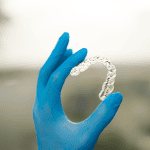Most of us have heard the line from the old song “your foot bone’s connected to your ankle bone”. Perhaps soon it will be completely accepted within the dental and medical communities to say that the health of the gums may be connected to several systemic diseases and conditions. Until now, the medical and dental fields have been viewed as being separate, but we now have a common enemy, periodontal disease, or more commonly known as gum disease. We as dentists have always been aware that after we removed severe oral infection, our patient’s general health improved. Now there is a growing body of research, done by highly respected scientists, showing links between diabetes, cardiovascular disease, preterm births, and other systemic diseases. There has been investigation into periodontal disease and systemic health for decades, but it has never been conclusive. With new research, we are seeing much stronger links; these are termed oral-systemic links.
Today people are living longer and gum disease has gained over tooth decay as the most common cause of tooth loss. It is estimated that 60 million Americans have moderate to advanced periodontal disease and that 30% of all adults have some form. Of Americans over 65 years of age, 80% are affected with some level of periodontal disease. At the turn of the last millennium, David Satcher, the U.S. surgeon general at the time, called periodontal disease the “silent epidemic”.
So what is periodontal disease, gum disease, trench-mouth (a term used for a specific type of gum disease that affected soldiers fighting in trenches) pyorrhea, stink-mouth or a variety of other less scientific names? While there a number of types of periodontal disease, we will discuss the overwhelmingly dominant form which typically starts with gingivitis and progresses to severe, acute periodontitis. There are over 400 species of bacteria that live in your mouth and not all of them are friendly. If you are not brushing and flossing correctly and/or enough, these bugs will take a toe-hold and start to form a nasty colony, which is an infection called gingivitis, under your gums. This area under the gum cuff is called your periodontal pocket, and should be measured and evaluated for depth and health during your dental cleanings. Gingivitis is the initial phase of gum disease; the signs of gingivitis are red gums which bleed when brushed and flossed; it is reversible with good oral hygiene and treatment by your dental hygienist. Prevention has always been the motto of the dental community, and this is where it starts with gum disease. If left untreated, gingivitis will progress to the first stages of periodontitis. A biofilm will start to form in the depths of the gum pockets. This bacterial ecosystem is a durable, reef-like structure, which is dependent upon the buildup and retention of progressive bacterial colonization. At this point the body sends in the army which is our immune system. It will kick in to fight the bacterial infection. However, it is our own body’s response, the inflammatory response which is associated with the immune system that does damage to us. It is this inflammatory response which causes a raw, open wound referred to as an ulceration on the inner lining of our gum pockets. The inflammation causes destruction of this gum lining and bone in the area which anchors our teeth into our jawbones. This is the process and if left untreated it will lead to chronic, chronic aggressive and acute periodontitis, with resulting tooth loss. The signs of progressing periodontitis are, red, swollen bleeding gums which are receding, giving you a “long-in-the-tooth” look. The teeth will become loose and painful and breath will become more and more horrible.
Due to the bone destruction and infected gum tissues, the periodontal pockets will become deeper and even harder for you to clean at home. It will require more advanced forms of cleanings in the dental office. Healthy periodontal pockets will have measurements of 1-3 millimeters (mm) and NO bleeding. As periodontal disease begins there will be 4mm pockets and deeper and bleeding. The treatment in the dental office then requires giving the patient some light anesthesia so the dental hygienist or dentist can remove all of the bacteria and tarter which is in the deeper pockets, this is called scaling and root planning or sometime referred to “deep cleanings”. As pockets increase it may be necessary to refer the patient to a gum specialist called a periodontist for evaluation and possibly gum surgery. Every dentist will have their own modality of treatment; there are many ways to fight the infection. The key here is to do something. Periodontal disease is much like high blood pressure, you don”˜t know you have it until it is advanced and has done damage. It is key to be preventative and see your dental team regularly, especially as we age.
Besides the loss of your teeth, which is bad enough, as this periodontal disease is progressing it is wrecking havoc on your entire system. This is where the latest research is concentrating on the oral-system link. As described earlier, as the bacterial colony becomes more organized it sends out toxins which alert the immune system to move in and fight the infection. This war results in inflammation and it is this inflammation which is the main culprit of the oral-systemic link. As the inner walls of the gum pocket ulcerate, a raw open wound is opened into the body. It is estimated that this ulceration would be the size of your palm in advanced periodontal disease. If this ulceration were on the outside of your body, say your leg and it never healed, a medical doctor would be alarmed and treat this infection, but in the mouth it is hidden and not real painful (until it is very advanced). The immune response causes the release of the body’s own cytokines which are known to be involved with damaging inflammatory processes in other parts of the body. Most significantly, the ulceration acts as an open door via the blood stream to other parts of the body. The bacteria, their toxins and the cytokines can then travel and do damage in other areas of the body. Inflammatory markers are a result. These show in the blood from the toxins going to the liver and stimulating their production. One of the markers is C-reactive protein or CRP another is fibrinogen. We know that these markers are evident in people with cardiovascular disease and in fact CRP is one of the measures for cardiovascular disease. In people with severe gum disease, a bacteremia, which is a bacterial infection in the bloodstream can start by simply chewing or tooth brushing, the bacteria just go directly into the blood stream through the ulcerated gum pockets. It all sounds fairly technical, but I think we can all imagine there will be damage to the rest of the body with bacteria in the blood stream.
When medical doctors treat cardiovascular disease (CVD), they know there are many factors associated with the cause of the disease, some which are genetic and not entirely controllable, like high cholesterol. However, there are factors that are controllable, like exercise, not smoking and good diet. Just in March of this year, the New England Journal of Medicine published a scientific article relating the affects of the health of the lining of the blood vessels and periodontal treatment. After intensive periodontal treatment was given to patients with severe periodontal disease, the health of the lining of the blood vessels was increased. In May of 2006, research showed that certain oral bacteria have genes that allow the organism to invade and infect the cells of the lining of arteries. Many other studies have been done recently leading to the possible CVD-oral health link.
One of the strongest oral-systemic links is associated with diabetes. People with diabetes are more susceptible to periodontal disease and once they have periodontal disease it seriously affects their health. The bacteria that go into the blood stream through the infected periodontal pockets cause infection. This infection makes it much harder for diabetics to control their blood sugars referred to as the glycemic control. Periodontal disease increases insulin resistance. Diabetic patients who maintain good glycemic control can prevent or delay the onset and slow the progression of complications associated with diabetes. These complications include kidney dysfunction, CVD, retinopathy and peripheral neuropathy.
Current research supports an association between periodontal disease and preterm births (PTBs) and low weight births (LWBs). PTB is the major cause of infant and long-term disability. Periodontal infections have been found to be more prevalent in pregnant women than all other obstetric and sexually transmitted infections combined. It has been estimated that 1 in 5 PTBs may be attributable to periodontal infections and periodontal bacteria have been found in the amniotic fluid.
Other areas of concern related to periodontal disease are links to Alzheimer’s disease, osteoporosis and pneumonia in the elderly. There is an increasing awareness among the dental community of how the elderly in rest homes are at greater risks from periodontal disease and pneumonia. It is difficult for the staff in these facilities to brush their patient’s teeth, and the patients can not do it themselves. Huge amounts of bacteria build up and the patients become more susceptible to pneumonia.
There is a vast amount of research over the past 20 years indicating an oral-systemic link. In the past 5 years this research has become more definite, especially with the advances in research technology. I believe the oral-systemic link will prove to more and more evident. Dentistry is ever-changing, I learn new techniques constantly on how to address periodontal infection, and this will continue as new evidence comes forward. Dentists and Medical doctors will need to become more and more allied in this area of treatment. It is teamwork and that includes more than anyone else, you the patient. Periodontal disease is impossible to find without an oral exam by a dentist and hygienist. It is also impossible to treat without the patient working consciously, everyday on their oral hygiene. Periodontal disease is preventable. It is also one of the infections which may be a “controllable” factor in many serious diseases. So, let’s take control.







